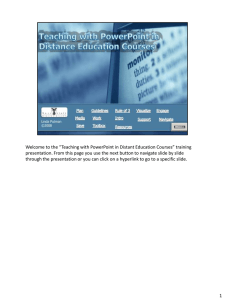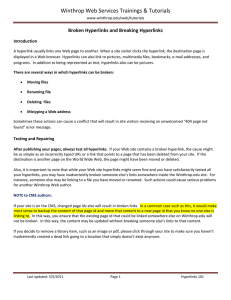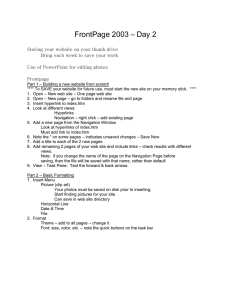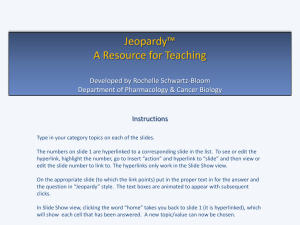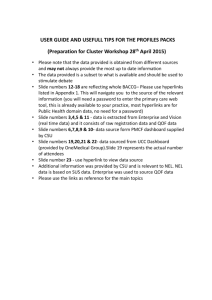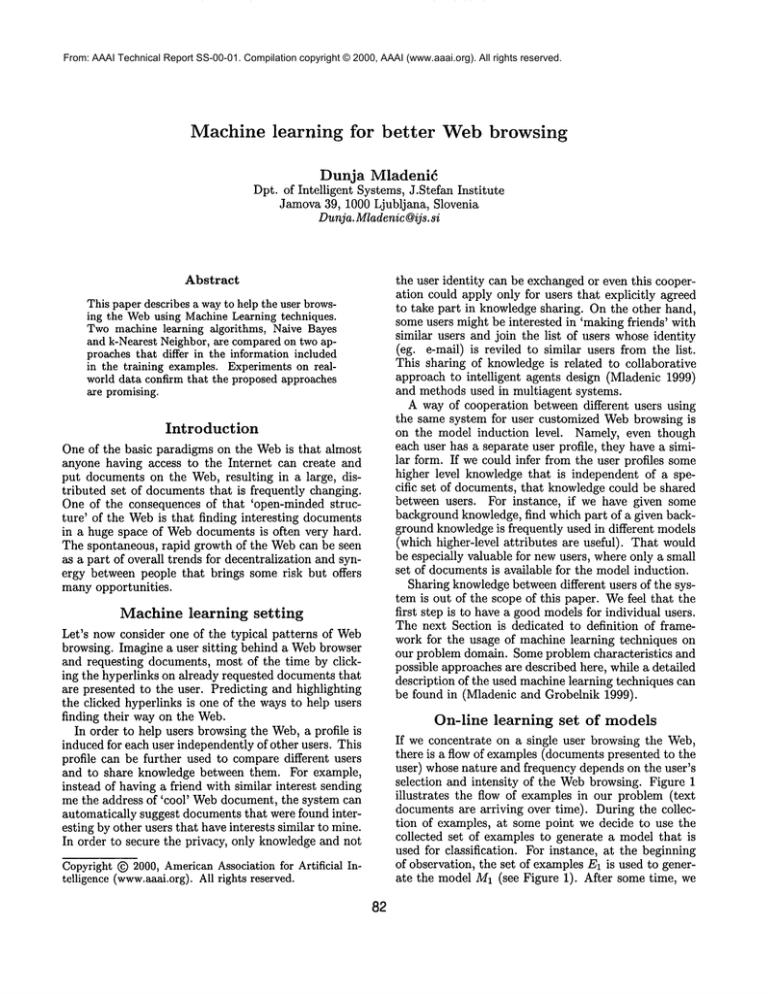
From: AAAI Technical Report SS-00-01. Compilation copyright © 2000, AAAI (www.aaai.org). All rights reserved.
Machine learning
for better
Web browsing
Dunja Mladeni(~
Dpt. of Intelligent Systems, J.Stefan Institute
Jamova 39, 1000 Ljubljana, Slovenia
Dunja.Mladenic@ijs. si
Abstract
the user identity can be exchanged or even this cooperation could apply only for users that explicitly agreed
to take part in knowledge sharing. On the other hand,
some users might be interested in ’making friends’ with
similar users and join the list of users whose identity
(eg. e-mail) is reviled to similar users from the list.
This sharing of knowledge is related to collaborative
approach to intelligent agents design (Mladenic 1999)
and methods used in multiagent systems.
A way of cooperation between different users using
the same system for user customized Webbrowsing is
on the model induction level. Namely, even though
each user has a separate user profile, they have a similar form. If we could infer from the user profiles some
higher level knowledge that is independent of a specific set of documents, that knowledgecould be shared
between users. For instance, if we have given some
background knowledge, find which part of a given background knowledgeis frequently used in different models
(which higher-level attributes are useful). That would
be especially valuable for new users, where only a small
set of documents is available for the model induction.
Sharing knowledgebetween different users of the system is out of the scope of this paper. Wefeel that the
first step is to have a good modelsfor individual users.
The next Section is dedicated to definition of framework for the usage of machine learning techniques on
our problem domain. Someproblem characteristics
and
possible approaches are described here, while a detailed
description of the used machinelearning techniques can
be found in (Mladenic and Grobelnik 1999).
This paper describes a wayto help the user browsing the Webusing MachineLearning techniques.
Twomachine learning algorithms, Naive Bayes
and k-Nearest Neighbor, are comparedon two approaches that differ in the information included
in the training examples. Experiments on realworld data confirm that the proposed approaches
are promising.
Introduction
One of the basic paradigms on the Webis that almost
anyone having access to the Internet can create and
put documents on the Web, resulting in a large, distributed set of documents that is frequently changing.
One of the consequences of that ’open-minded structure’ of the Webis that finding interesting documents
in a huge space of Webdocuments is often very hard.
The spontaneous, rapid growth of the Webcan be seen
as a part of overall trends for decentralization and synergy between people that brings some risk but offers
many opportunities.
Machine
learning
setting
Let’s now consider one of the typical patterns of Web
browsing. Imagine a user sitting behind a Webbrowser
and requesting documents, most of the time by clicking the hyperlinks on already requested documents that
are presented to the user. Predicting and highlighting
the clicked hyperlinks is one of the ways to help users
finding their way on the Web.
In order to help users browsing the Web, a profile is
induced for each user independently of other users. This
profile can be further used to compare different users
and to share knowledge between them. For example,
instead of having a friend with similar interest sending
me the address of ’cool’ Webdocument, the system can
automatically suggest documents that were found interesting by other users that have interests similar to mine.
In order to secure the privacy, only knowledgeand not
On-line
learning
set of models
If we concentrate on a single user browsing the Web,
there is a flow of examples (documents presented to the
user) whose nature and frequency depends on the user’s
selection and intensity of the Webbrowsing. Figure 1
illustrates
the flow of examples in our problem (text
documents are arriving over time). During the collection of examples, at some point we decide to use the
collected set of examples to generate a model that is
used for classification. For instance, at the beginning
of observation, the set of examplesE1 is used to generate the model M1(see Figure 1). After some time,
Copyright(~) 2000, AmericanAssociation for Artificial Intelligence (www.aaai.org).All rights reserved.
82
collect some new examples (the set of examples E2) and
want to generate a new model M2. There are several
possibilities for the data selection for the generation of
the new model M2: from the latest examples only (E2),
from all examples (El t3 E2), by modification of the old
model M1using the latest examples E2. In all the three
cases we assume that only the last generated model (in
this case M2)is used for classification. There is also
fourth possibility, namely, to generate each model from
a separate set of examples and use some combination
of the models for classification (M1generated from El,
M2generated from E2, ... ). This last approach was
proposed by Breiman (Breiman 1996) in machine learning on large datasets and on-line learning (arcing).
arcing, the subsets of incoming examples are taken and
used to generate a new model. Subsets are formed to
include examples that are incorrectly classified by old
(aggregated model) and probabilistically include the examples that are classified correctly. All generated models are stored and used for classification combined by
voting.
Documents
arriving
I
I
I
Dj-1ij ...
-,,DID
[--~[~(DID2 .~jDi,’Di+k
...
I
,,
/
I
I
I
endsession,
I
’
El
MI
I
I
I
U
time
I
E2
’
M2 ...
startofobservation
Figure 1: Illustration of the data collection process
while the user is browsing the Web. Text documents
D1, D2, ...are arriving over time as request by the
user.
There are different questions that should be addressed, for instance, what information to include in the
training examples, how to represent documents, how to
reduce the high number of features, how to generate
new background knowledge, how to include background
knowledge in the model generation. Someof them are
addressed in (Mladenic and Grobelnik 1999).
Learning a single model
In order to get a set of models, we have to decide what
is the target function, we want the model to approximate. Wehave identified two interesting problems (target functions): predicting clicked hyperlinks and predicting interesting hyperlinks. In this paper the first
problem is considered that is predicting the hyperlinks
that the user is going to click on. For the simplicity,
we will refer to this hyperlinks as clicked hyperlinks.
83
The rest of this section briefly describes the both problems.
Predicting
clicked
hyperlink
For the problem of predicting clicked hyperlink, the
simplest solution would be to have a binary-valued
class. In this way some existing text-learning methods
can be used. In this case all the hyperlinks clicked by
the user are considered positive examples and all other
hyperlinks that were shownto the user (but remain unclicked) are negative examples. This partially already
captures user interests.
However, in many cases user
didn’t click on a hyperlink just because the lack of time
and also probably didn’t find interesting all the visited
documents.
This approach could be adapted for the problem of
suggesting interesting hyperlinks, if we are prepared to
accept that all the documents visited by the user were
interesting to the user and that un-clicked (or random)
documents are uninteresting. Of course, the simple solution to that would be to ask the user for document
rating but we do not want to put additional work to
the user.
Predicting
interesting
hyperlink
Predicting interesting hyperlinks can be performed by
predicting clicked hyperlinks as described in Section .
Noise in the class value can be reduced by learning
from the clicked hyperlinks (positive examples) only.
This would in our case require solving at least three
additional problems: (1) finding an appropriate learning algorithm, (2) finding an appropriate feature selection method, and (3) proposing a suitable result evaluation. (1) There is not much work on learning from
positive examples only. The best known approach is
the association rules induction that is widely used on
large databases. On the other hand, some of the existing learning algorithms such as k-Nearest Neighbors
can be also used, if a threshold is introduced defining
the maximumdistance from positive examples in order for a new example to be classified as positive. (2)
Most feature scoring methods used for feature selection in learning over text documents assume that there
are at least two different class values. One very simple
method that does not have this requirement is a word
frequency. (3) In order to evaluate the result of learning
(the induced knowledge model), we need some method
for the model evaluation. Evaluation methods that are
commonlyused in information retrieval (eg., precision,
recall) or in machinelearning (classification accuracy,
information score) are all based on the assumption that
there are at least two different class values. Weare currently not aware of some general method designed for
the evaluation of models in domains with only positive
examples. The possible way to evaluate a model that
returns probability for each hyperlink would be to maximize the average predicted probability of clicked hyperlinks. In general, the method would try to maximizethe
average predicted probability of positive examples.
Experiments on predicting
hyperlinks
Modelof user interests
clicked
(HL) is defined to include the actual hyperlink from
HTML-documentand some of the its context (titles,
neighboring words). (2) Retrieving documents pointed
to by hyperlinks on a requested document means that
the model will be induced from documents UserDoc :
Document --4 {pos, neg}. The reason we can afford
thinking about retrieving documentsis that the classification model is induced "off-line", meaning that the
induction is not so time critical as classification. The
time critical part is classification, since usually the user
is sitting behind the Webbrowser waiting for the requested document. Before showing the document to
the user, we are modifying it by highlighting some of
the included hyperlinks according to the results of the
classification process in which the documentis used.
Our experiments are performed using our personal
browsing assistant named Personal WebWatcher. Personal WebWatcheris a system that observes users of
the Weband suggests pages they might be interested
in. It learns user interests from the pages requested by
the user. The learned model is used to suggest hyperlinks on new HTML-pagesrequested by and presented
to the user via Webbrowser that enables connection to
"proxy".
..............
¯
%_ J~
J__Z. ~,~,k,
[,,,o,
L_J
-
LEARNER
,. ..............
Figure 2: Structure of browsing assistant
Watcher.
Personal Web-
Helping the user browsing the Webis performed here
by highlighting interesting hyperlinks on the requested
Webdocuments. Weassume that the interesting hyperlinks are the hyperlinks that are highly probable to be
clicked by the user. Our problem is defined as predicting clicked hyperlinks from the set of Webdocuments
visited by the user. All hyperlinks that are present
on the visited documents are used for constructing machine learning examples. Since the prediction should be
performed while the user is waiting for a document, we
are actually predicting interestingness of a document
based on the hyperlink pointing to it, and not the document itself. Webuild descriptions of hyperlinks, and
treat these as shortened documents. Hyperlinks whose
documents were visited by the user are considered to
be positive examples, and all the other to be negative
examplesof the user interests. The idea is that different hyperlinks were presented to the user and the user
chose to visit someof them that meet her/his interests.
This simplification is introduced to minimize users involvement in the learning process and enable learning
without asking user for page rating.
Weconsider two approaches that differ in the information included in training examples: (1) include information presented to the user, that is a part of the text
from the document that contains a hyperlink and (2)
include information that was not presented to the user,
that is the content of the document pointed to by a
hyperlink. (1) Generating examples from the information presented to the user on the requested document
means using machine learning to model the function
USerHL : HyperLink --~ {pos, neg}, where HyperLink
84
Userid.,
prob. of
data source interestingness
usr150101
Doc
0.094
HL
0.104
usr150202
Doc
0.107
HL
0.053
usr150211
Doc
0.089
HL
0.044
usr150502
Doc
0.100
HL
0.100
# of
examples
data
entropy
1 333
2 528
0.449
0.480
3 415
4 798
0.492
0.301
2 038
2 221
0.436
0.259
1 272
2 498
0.468
0.468
Table 1: Data characteristics
for document (Doc) and
hyperlink (HL) data for each of the four HomeNetusers.
In both cases, classification
is performed on
HyperLinks that in the second solution can be viewed
as a kind of HTML-documents. In (1) the model induced from HyperLinks is used for classification while
in (2) the model induced from the Documents pointed
to by hyperlinks is used. In this paper we use the first
approach that requires less time to collect data and results in domaincontaining less features (smaller vocabulary is used).
Experimental
results
Wemeasure classification accuracy, defined as a percent
of correctly classified examples and calculated over all
classes. Our testing is performed with 10-fold crossvalidation using the same examplesplits for testing different approaches.
Weobserve how the number of selected features (vector size) influences model quality for two learning algorithms: Naive Bayesian classifier and the k-Nearest
Neighbor algorithm. Weuse the Naive Bayesian classifier on text as proposed in (Mitchell 1997) where the
feature independence assumption is used for different
words as well as for different occurrences of the same
word. In this approach documents are represented with
bag-of-words (unigram model of text is used) where
feature is defined for each word position in the document having word at that position as the feature
f-..........
......f..........
E+tt--I
............
Is
IIII I t---
Figure 3: Influence of the number of selected features to classification accuracy of model based on documents (DOC)
and hyperlinks (HL) for the HomeNetproject user 150211 (left two) and user 150502 (right two). Weshow
value and standard deviation of 10-fold cross validation.
References
value. Recall that in the bag-of-words representation
only words, and not their positions, are considered.
Thus a document can be seen as a set of words, where
each word is assigned a frequency - the numberof times
a word occurred in the document, k-Nearest Neighbor
was applied on frequency vectors using Euclidean distance between examples and summing class probabilities predicted by k-neighbors as used in (Yang 1994).
Wetested both algorithms on data for each approach
UserDoc and UserHL (see Section ). Documents are
currently represented using the bag-of-words representation and feature selection is performed using information gain (Quinlan 1993). Our experiments are performed on data collected for four users participating in
the HOMENET
project (HomeNet 1996) with the data
characteristics given in Table 1.
In all experiments k-Nearest Neighbor achieved
slightly higher classification accuracy than the Naive
Bayesian classifier (see Figure 3), but the difference
significant only in one out of the eight experiments (the
first graph). Using more than approximately 50 features doesn’t appear to help for classification accuracy,
but it also doesn’t hurt. High classification accuracy
achieved for all four users by k-Nearest Neighbor algorithm is not much higher than the default accuracy
(achieved if negative class is predicted for all testing examples). This indicates that some other model quality
estimate should be used, for instance, Precision-Recall
combination as used in (Mladenic and Grobelnik 1999).
In order to draw some conclusion about vector size
and quality of algorithms, we need to perform more experiments on different users. These experiments show
that increasing vector size probably isn’t as beneficial as
one could expect. There is no evidence that algorithms
differ substantially in classification accuracy, although
k-Nearest Neighbor seems to be more promising. If further experiments confirm the hypothesis that long vectors are not advisable, a closer look at the short vectors
should give an idea about the appropriate number of
features.
Acknowledgements This work was financially
supported by the Slovenian Ministry for Science and Technology. Part of this work was performed during the
authors stay at Carnegie Mellon University in. Tom
Mitchell’s group.
..
Breiman, L. (1996). Pasting bites together for prediction in large data sets and on-line. Berkeley University,
November.
Kraut, R., Scherlis,
W., Mukhopadhyay, T., Manning, J. & Kiesler, S. (1996). The HomeNet Field
Trial of Residential Internet Services. Communications of the ACM12, (Vol. 39), pp. 55-63.
http://homenet.andrew.cmu.edu/Progress/
Mitchell,
T.M. (1997). Machine Learning. The
McGraw-Hill Companies, Inc..
Mladenid, D. (1999). Text-learning and related intelligent agents. IEEE EXPERT,Special Issue on Applications of Intelligent Information Retrieval, May-June
1999.
Mladenid, D. & Grobelnik, M. (1999). Feature selection for unbalanced class distribution and Naive Bayes,
Proceedings o/ the 16th International Conference on
Machine Learning ICML-99, Morgan Kaufmann Publishers, San Francisco, CA. pp. 258-267.
Pazzani, M., & Billsus, D. (1997). Learning and Revising User Profiles: The Identification of Interesting
Web Sites. Machine Learning, 27, 313-331. Kluwer
Academic Publishers.
Quinlan, J.R. (1993). Constructing Decision Tree.
C,~.5: Programs for Machine Learning. Morgan Kaufman Publishers. pp. 17-26.
Yang, Y. (1994). Expert Network: Effective and Efficient Learning form HumanDecisions in Text Categorization and Retrieval. Proc. of the 7th Annual International A CM-SIGIRConference on Research and
Development in Information Retrieval, ACMPress,
NewYork, pp. 13-22.
85

